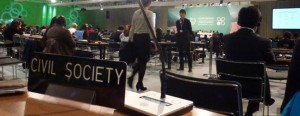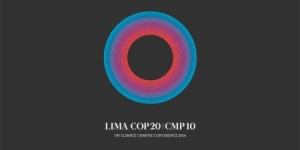by Klever Descarpontriez & Maria Alejandra Escalante(and many friends)
Climate change impacts show no patience with the slow pace of progress at the intergovernmental negotiations and the very limited amount of actions being taken to halt global warming. We are already facing the impacts: sea level rise has displaced island communities in Bangladesh, droughts have decreased yields by 50% in Guatemala, typhoons have taken the lives of hundreds in the Philippines, Peruvian Andean glaciers keep melting, and the list of collateral impacts like loss of biodiversity, deforestation, and desertification goes on and on.
These manifestations are just the tip of the iceberg. To the date, the global temperature has already increased by 0.8℃ since the 1900s, and countries are already experiencing tremendous hardships and difficulties coping with the impacts. The world needs strict, radical, top-down rules coming from the governments at the UNFCCC. During this next year, their duty is to make global carbon emissions peak by 2017 in order to have a 50% chance to stay below a 2℃ increase of global temperatures. For this to happen, major polluters have to dramatically ramp up their mitigation efforts and match the level of ambition that is needed (check out this website to understand more about the fair uses of atmospheric space from a climate justice perspective). If emission reduction targets are not met by their due time, then, we should start accepting the idea of a world where catastrophic events, like small island states disappearing causing massive migrations of climate refugees, becomes our bleak common reality.
Climate change is here, it is real, and its impacts are getting more severe by the day. The UNFCCC has the objective of stabilizing “greenhouse gas concentrations in the atmosphere at a level that would prevent dangerous anthropogenic interference with the climate system” (Article 2 of the UNFCCC Convention text). But greenhouse gas emissions have increased exponentially since the establishment of the UNFCCC in 1992. However, sadly, the UNFCCC, the most prominent international body where climate change is being addressed, has failed to deliver results. Why is there no real and effective climate action? For the past twenty years, the most fundamental principles of the Convention which construct the ideas of climate justice and equity—like historical responsibility and common but differentiated responsibilities (CBDR)—have been undermined, forgotten, ignored and conveniently manipulated by developed countries. Without the implementation of these principles in the new agreement, the result will be unfair. For developing nations (about ¾ of the global population), an unfair agreement means that they will have to keep enduring a world that is increasingly warmer and harsher. These are conditions that the Global South did not create in the first place. This panorama is unfair and unsustainable.
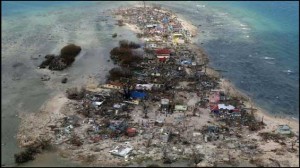
We have witnessed how politically contested the climate negotiations are. We have seen dirty politics at the UNFCCC (remember how Bolivia got crushed by developed countries bullies in Cancun?) and the invisible hand of corporations and financial institutions behind developed countries’ interests. This year’s COP20 in Lima will be no different. The expected new agreement, a potentially legally-binding document, will dictate the type of climate action that member states will carry on for at least the coming decade.
As you can imagine, the process of defining the content and scope of this new agreement will probably transform the UNFCCC into a battlefield. The possibilities on the table range between two contrasting views: on one hand it could finally enforce the mitigation commitments for developed countries that the Kyoto Protocol did not achieve and actually deliver the finance for adaptation, technology transfer, and capacity building that have been promised since 2007 at Bali. On the other hand, it could totally become another file in the archive of useless documents. The potential dangers of this new agreement are that, if agreed under weak terms, it could lock the world in climate inaction and backwardness for crucial years in which drastic mitigation must happen. It could also erase the differentiation of responsibilities towards climate change between the global North and South which is something clearly stated in the Convention (more on that below).
Here we cover some of the most polemic issues at COP20 under this new agreement, the expected course of negotiations and the red lines that must not be crossed for this new text to deliver climate justice at the UN halls. The negotiation of the new agreement is the biggest battle to be seen at COP20 Lima, but there will also be other important struggles worth engaging with.
Stay tuned as we keep writing about the development of the new agreement and other contested issues that will come up in the next two weeks.
____________________________________________________________
The ADP: this is how we call the negotiations of the new agreement
After a rather disappointingly slow and unproductive session of the Ad-Hoc Working Group on the Durban Platform for Enhanced Action (otherwise known as the ADP) in Bonn at the beginning of October, where little or no substantial progress was attained (Earth Negotiations Bulletin did a thorough summary of this session), it is now crucial that negotiators switch to actual negotiating mode to make up for all the time wasted in open-ended consultations. The urgency increases exponentially with a deadline for a new climate agreement approaching with gigantic steps.
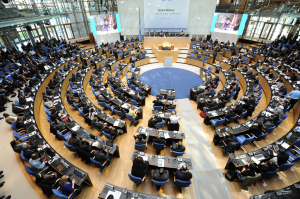
The work under the ADP has been divided into two workstreams to facilitate the advancement of work. You have ADP workstream 1 (or WS1 – the 2015 agreement). Its mandate is to make available a negotiating text before May 2015 to allow nations enough time to revise and amend it before they meet once again to sign it in Paris by the end of the same year. This new agreement is meant to come into force in 2020 (a little late according to science – if we are to stay below the 2C goal we must peak global carbon emissions BEFORE 2020). And you have workstream 2 (or WS2 – pre2020 ambition) mandated to identify or explore options that can close the ambition gap—the ambition gap is the difference between the aggregate emission reduction pledges made by the governments so far, and the amount of emission reductions that the science (IPCC AR4) indicates is necessary in order to stay within the emission reduction pathway consistent with a global warming no greater than 1.5 to 2℃.
Under WS1 you find two more negotiating tracks being discussed and highly important at COP20 in Lima: the ‘Intended Nationally Determined Contributions’ (or INDCs) and the ‘Elements’ of the new agreement.
Under this new climate agreement “with legal force under the Convention applicable to all Parties”, the INDCs are each Parties’ contributions towards a more stable climate. It is important to note that these are called contributions, since developing countries opposed the other C-word (commitment), explaining that they are not in a position to be taking legally binding commitments—lifting millions of people out of poverty still remains top in their agendas—and the Convention says these commitments belong only to Annex-1 countries. Contributions is a very tricky word because as soon as these ‘contributions’ are proposed, they get written on paper and become part of a new agreement—they become ‘commitments’ under international law.
The elements, as the name clearly states, are other components that need to be taken into account when writing the new climate agreement. As mandated, the ADP should encompass: mitigation, adaptation, finance, technology development and transfer, transparency of action and support, and capacity-building. Moreover, as it is a party-driven process, any output has to draw from inputs from parties’s submissions and reflect on those. Lastly, it has to be informed by the 5th Assessment Report by the IPCC, the 2013-2015 review program and the other subsidiary bodies.
We have to think of the two work-streams as two trains that left the station in Durban in 2011 together and that need to arrive to Paris at the same time by 2015. Despite being equally important and having to inform each other, WS1 has gained more traction than WS2 and is going way faster (with almost no stops—and absurdly focused only on mitigation).
INDCs: how each nation will “contribute” to solve the climate crisis
It is clear what developed countries want: a new legal instrument to replace the Kyoto Protocol. They want it to have new mitigation commitments for all countries, markets, MRV (measuring, reporting, verification), weaker provisions to them, yet stronger to developing countries. In the case of developing countries their objective is a little bit harder to assess for they are not a homogenous bloc. There is a lot of diversity in the G77. All we can be sure about is that the Global South does not want this new agreement to be just about mitigation. The G77 is fighting for a balance in the way the other elements are treated or dealt with.
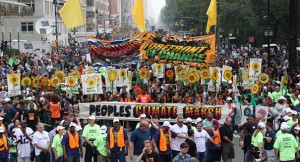
The state of the game at the current climate talks is terribly worrisome for many of us who advocate for climate justice in the negotiation spaces. The discussion has shifted towards the contributions rather than what the contributions themselves are meant to be there for, i.e. the elements. You simply cannot expect or ask developing countries to put forward their intended nationally determined contributions if they do not know (or have zero guarantee of) whether they will be receiving finance from the North or if the other elements will be part of the new agreement.
Now, what happened to the other demands that developed countries do not want in the instrument, but developing countries want and need like technology transfer and finance, adaptation, loss & damage? Developed countries say these other elements will not go into the legally binding agreement, but they will go into the Paris Package. A package has never been a good idea because it usually gets negotiated later on, it is a blurry cloud where things can get lost, most worryingly is that ‘packages’ are usually hard to reopen for debate at the last minute of the last day of negotiation. Packages work in a take-it-or-leave-it basis. For this new agreement to be just and foremost fair, the instruments need to be balanced and all the demands mentioned above have to be given the same weight.
What is so problematic about the nature of the INDCs is that the differentiation of responsibilities between developed and developing countries gets erased. INDCs ask for mitigation contributions from all parties, as if all nations were equally responsible for climate change. INDCs ignore the historical emissions of the largest polluters of the Global North and the responsibility of mitigation that comes along. INDCs want to make the Global South equally accountable for a crisis they did not cause. Ignoring this differentiation means that there is no more justice at the negotiating table, it dissipates the possibility of recognizing and paying the climate debt, and it undermines the very foundations of the Convention. Historical amnesia is probably one of the most violent ways to ignore the demands and needs of all those frontline communities that have historically and continually endured the impacts of climate change and the system that perpetuates this crisis. If we want to see any sort of fair process at the UNFCCC, public acknowledgement of history must be the first block that gets settled. Otherwise, this negotiation space is just going to keep perpetuating the same injustices of the past.
Elements: everything that is supposedly not about mitigation
Adaptation – there are talks on what would a country’s adaptation look like. Parties are discussing global goals, commitments, institutional arrangements or how to anchor them to the new climate agreement (for instance, institutional commitments, the Adaptation Committee, the International Warsaw Mechanism on Loss and Damage). In the last Bonn meeting some countries were already talking about these three points above. There were even more talks on adaptation related to mitigation. How much of X-mitigation that happens will determine how much of y-adaptation needs to happen.
Finance – Lima will be a fight about the amount of money available. The same fight since the end of fast track finance. It will be different in Lima because there will be pledges this time. But this does not mean the money is flowing. Developing countries have been saying that finance is a red line and without it they would not allow the COP outcome, but they have backed off that red line in the last two COPs. There are pledges this time and now developing countries are in a weaker position to bargain. Under the GCF $100 billion a year by the year 2020 was pledged by developed countries. However, the level of ambition towards achieving this goal is extremely low and at the GCF pledging conference on the 20th of November only $9.3 billion dollars were pledged. Some blocs like the Africa Group demanded that by 2014 the amount pledged should be around $32 billion, and compared to what has been pledged, these numbers are only a distant dream.
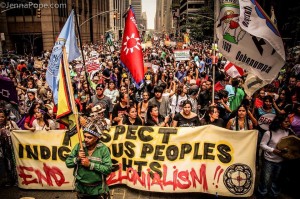
Loss and Damage – many questions were raised about the Warsaw International Mechanism for Loss & Damage and how this could be brought into the ADP discussions. Developing countries want it in the Paris Agreement. Now is the time to pull it in if it needs to have a long life. The Warsaw International Mechanism on Loss & Damage was established last year at COP19 and placed under adaptation work after strong opposition from Canada, Australia, the EU and the US. This mechanism should address the losses and damages that climate change has generated on the most vulnerable peoples and communities when absolutely all mitigation and adaptation actions have been taken to stop the onset events and impacts that come with climate change. Therefore its work does not belong to either mitigation or adaptation. The mechanism currently is up for review in 2016, hence effectively leaving it out of the current conversations. A way to pull it back into the ADP talks – as proposed by AOSIS – is to establish it as an element and a key pillar like those of mitigation and adaptation.
Transparency – Transparency of action and support is the element that deals with aspects of differentiation, flexibility, accounting and MRV (Measuring, Reporting and Verifying). Developed countries (like New Zealand, Norway etc.) have been using it as a sneaky way to push market mechanisms, especially a global carbon market into the new agreement. Even though they do not want anything binding, they still want a system by which they can keep using flexible markets. Markets are an important element for them that can be implemented through transparency. Hence, what they want is a strict counting system to keep the markets going. Developing countries prefer reporting, verification and a definition of climate finance. Lastly, developed countries now want transparency on South-South finance. China is upset, rightly so, because South-South finance is not something under the Convention.
Green Climate Fund – there is an expectation that the GCF is anchored in the new agreement. Developing countries demand that finance gets included under the GCF. Developing countries are wondering about anchoring the Adaptation Fund too. There is a lot of how much and by when. Under the GCF governing instrument, it is stated that the funds are to be allocated equally to mitigation and adaptation. Unfortunately, at this point, adaptation funding is only a meagre 15-25% and the rest is going towards mitigation. It is important to remember that the GCF is a fund and not a bank and to manage the money it has to flow through intermediaries like the World Bank. Developing countries are fighting for “direct access” which means that national institutions can access the money, and some more radical countries are pushing for “enhanced direct access” which means all decision making power goes to national entities. Another thing to look out for would be the Private Sector Facility (PSF) of the GCF. Developed countries do not feel like they are able to pay the amount they owe to the developing world so they are looping in money from big multinational corporations to help fund the GCF (for example the US said that ⅓-¼ of its pledged amount would be public funding and the rest would be private).
Land-Use – measurement schemes of GHG emissions from land-use are negotiated in the new agreement as part of Agriculture, Forests, and Other Land Uses (AFOLU), and not as Land Use, Land Use Change and Forests (LULUCF) anymore, which belonged to negotiations under the Kyoto Protocol. Currently, all countries under the UNFCCC report back from their land-use and only developed countries are accountable for the emissions generated from this. Since most developing nations depend heavily on the agricultural sector, developed countries want to make them accountable for their emissions as well, based on the idea that every country needs to mitigate (thus erasing the differentiation between annexes). But making developing countries accountable for their land-management ignores their need to obtain food security and sovereignty in the first place and to secure the rights of their land-based communities, as well as ignoring the difference of land-use emissions between sectors (for example, between industrial and subsistence agriculture). A common measurement scheme for accountability that includes all countries and all types of land-uses also allows for loopholes to appear in terms of emission reductions from land-use. A fair outcome in regards to land-use will be one that integrates a human rights-based approach in which different emission targets are set for different land-use sectors. Developing countries must keep pushing for this differentiation, since that is the only fair way of dividing mitigation responsibilities in terms of land-use and land-use planning.
